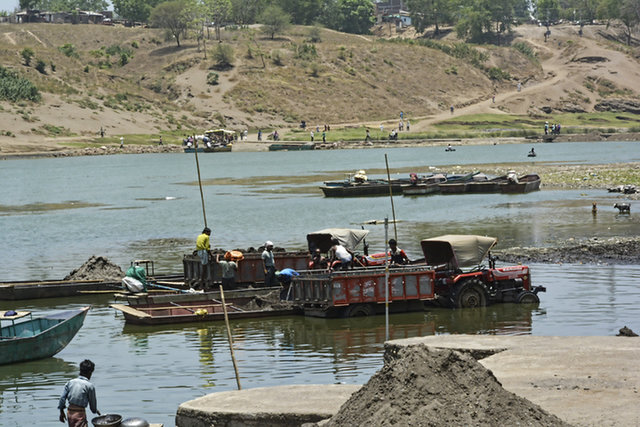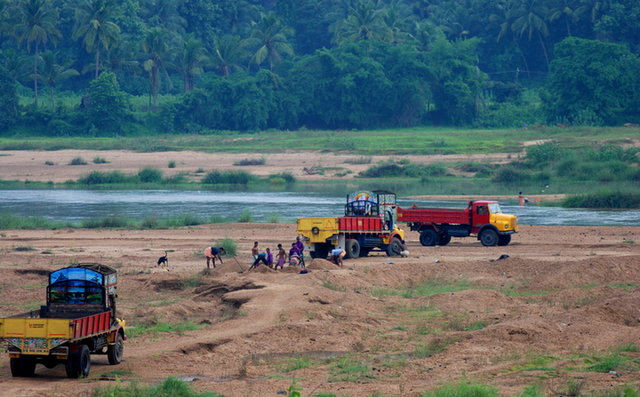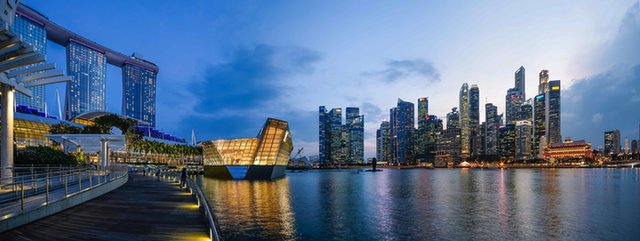COMMODITIES
Six things you need to know about sand mining
Think of the materials we mine, and you’ll probably think first of gold and other precious metals, of coal, of base metals like nickel and of battery metals like lithium. You probably won’t think of sand, but those tiny grains form a large part of the most heavily mined commodity on the planet: aggregate. Matthew Hall breaks down everything you need to know about sand mining.


Sand is the single most mined commodity, eclipsing minerals and metals by a colossal margin. Around 85% of the material we pull up from the earth is sand, gravel or other aggregate materials. Sand is also the most consumed substance after water, being used in virtually every construction or manufacturing process, even used as an ingredient in toothpaste.
Globally our annual aggregate consumption is somewhere around 53 billion tonnes - the equivalent to every person on earth using 20kg of sand every single day. And with rapid global urbanisation, particularly owing to economic growth across East Asia, the demand for sand is only increasing: since the early 2000s, China has used more sand every three years than the United States used in the entire 20th century.
More than half of the country’s coal mines are managed by pro-Russian separatist militia.Credit: DmyTo/Shutterstock.
More than half of the country’s coal mines are managed by pro-Russian separatist militia.
Credit: DmyTo/Shutterstock.
Sand is everywhere, but we’re running out of it
Our planet is covered in sand. The Sahara Desert alone covers 8% of the land area on the planet, and at 9.2 million km2 is roughly the same size as China. Sand dunes in the Sahara can be up to 180m high, the height of the City of London’s skyline staple The Gherkin. There is, to put it mildly, a whole lot of sand in the Sahara, and that’s just one of the world’s many deserts.
“The sand we need is the jagged, angular grains you might find in riverbeds and banks, in lakes and along shorelines.”
The problem with desert sand is that it is functionally useless. The grains have been weathered by wind, leaving them smooth and rounded – and impossible to work into concrete, which the overwhelming majority of harvested sand is used for.
The sand we need is the jagged, angular grains you might find in riverbeds and banks, in lakes and along shorelines. Here is where you’ll find silica sand, which is melted down to make glass for windows, windshields, and smartphone screens. So ravenous we are for that material that coastlines are being eroded, ecosystems destroyed, and entire islands removed from maps in Indonesia.

Sand mining activity on riverbanks such as Tapti in India is on the rise. Image: India Water Portal/Flickr
Existing regulation isn’t doing enough
Despite forming the bulk of mining activity, and being one of the top traded commodities by sheer volume, aggregates are highly unregulated. A 2014 report by the UNEP estimated annual sand consumption somewhere between 47 and 59 billion tonnes, but that figure is based on a proxy: we can track cement production far more easily, and every ton of cement requires between six and seven times that amount of sand to produce.
Scientists estimate that the weathering of mountains and rocks by rivers and glaciers delivers 12.6 billion tonnes of sediment to oceans each year. By the most conservative approximation, we are extracting sand more than three times faster than nature can replenish it.
“A 2014 report by the UNEP estimated annual sand consumption somewhere between 47 and 59 billion tonnes.”
In a 2019 UNEP report into sand sustainability, it was concluded that existing legal frameworks can provide a starting point to regulation, but they do not go far enough. The breadth of the commodity’s reach across multiple industry sectors, as well as conservation efforts, means that the issue requires a fully integrated view on governance, planning, and management of the resource – or sand extraction risks falling through the cracks into informal, potentially illegal practices.

AusProof is celebrating 25 years of business in Australia in 2019.
People have been killed for sand
Police officers have been crushed to death, journalists burned, and protesters shot. Sand is a vital resource, and can command a high price, so has attracted the attention of criminals. So-called sand mafias – illegal and often violent sand miners – are groups that illegally dredge sand from prohibited areas.
“Sand mafias are a particular problem in India.”
Indifferent to environmental regulations, their actions have caused untold environmental damage, with the UNEP warning that their activities are removing natural flood protections, exacerbating pressures on shorelines and riverbeds already threatened by climate change. Along Morocco’s Atlantic coast, the UNEP says illegal sand miners “have transformed a large beach into a rocky landscape between Safi and Essaouira.”
Sand mafias are a particular problem in India. In January of this year, 36-year-old Sangeeth Balan was bludgeoned to death with the arm of an earthmover when he resisted a gang of illegal sand miners who arrived at his residential compound with trucks and excavators. Sand mining is regulated in the country, but these regulations are difficult to enforce, and rumours of corruption undermine confidence in tackling sand mafia activity.

Illegal sand mining activity at the Nila in India. Image: Arayilpdas/Wikimedia Commons
Singapore is the biggest importer
Singapore is the world’s largest importer of sand, owing to its land reclamation activities which have seen the city-state’s land area increase by 20% in 40 years. Singapore had traditionally used sand from neighbouring states, before using up the resource and turning to importing from Malaysia, Vietnam, Indonesia and other Southeast Asian countries.
Export of Indonesian sand to expand the land area of Singapore has put at least 80 of Indonesia’s 17,508 islands at risk of disappearance due to sand extraction. Owing to the economic and environmental burden Singapore’s sand imports placed on these countries, nations including Cambodia, Malaysia and Vietnam have since moved to ban exports to Singapore entirely.
“Lax and often unenforceable regulation of the global sand industry has seen Singapore’s acquisition of sand go relatively undisturbed.”
However, lax and often unenforceable regulation of the global sand industry has seen Singapore’s acquisition of sand go relatively undisturbed: a 2014 UNEP report into global sand mining observed a shortfall of 120 million tonnes between Indonesia’s reported sand exports to Singapore versus Singapore’s reported imports of Indonesian sand between 1995 and 2013.

Singapore’s Marina Bay, an affluent downtown area of Singapore, was constructed on reclaimed land.
Image: Benh Lieu Song/Flickr
The best current solution is to rethink construction
In 2019, the UNEP noted existing solutions that could be implemented to reduce damage to ecosystems, as well as risks to communities and workers around sand extraction sites.
“Dubai’s 828m tower was constructed with a record-breaking 330,000m3 of concrete and 103,000m2 of glass.”
The report called for an overhaul of how we design and construct buildings and infrastructure to reduce sand and gravel demand to responsible levels. One way to do this is through reducing unnecessary consumption of sand: almost a third of Dubai’s office space was vacant in 2014, and the report cited the Burj Khalifa as a symbol of prestige rather than a building designed to serve a necessary function. Dubai’s 828m tower was constructed with a record-breaking 330,000m3 of concrete and 103,000m2 of glass.
To reduce sand consumption, we need a radical rethink of our infrastructure and construction projects, and the UNEP says this sustainability focus must be designed-in to future projects.
Innovation could reduce sand consumption
One avenue to reducing sand extraction is implementing a more rigorous recycling infrastructure and moving toward a circular economy for concrete. In the US, most recycled concrete is used as aggregate in road base, with less than a quarter being used to produce new concrete.
Recycling glass into glass sand has demonstrated qualities similar to natural sand, with no loss of strength. Using larger particles of crushed glass to produce concrete can reduce CO2 emissions by up to 18%, and studies have shown recycled glass can be used for beach replenishment, both reducing shoreline damage by sand extraction while also reducing the amount of glass that goes to landfill.
“Using larger particles of crushed glass to produce concrete can reduce CO2 emissions by up to 18%.”
Research from the University of Bath and India’s Goa Engineering College found that sand sized PET particles from recycled plastic bottles gave the best results when testing plastic as a potential replacement for sand in concrete. The plastic alternative achieved a target compressive strength of 54MPa, similar to the strength of concrete. By replacing just 10% of the sand used in concrete with plastic, the study estimated that 820 million tonnes of sand could be saved per year.
